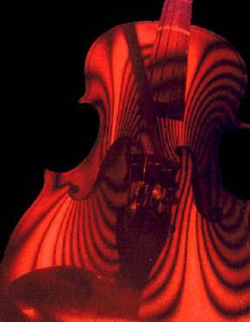Deflating Vacuum Energy

Treating the Universe as a hologram might solve one of the biggest problems bedeviling modern physics. According to quantum field theory, the expansion rate of the Universe should be accelerating wildly, much faster than it is. A theorist publishing in the 19 August print issue of PRL points out that the so-called holographic principle, which has arisen from quantum gravity research, could resolve this decades-old quandary.
Since 1998, most astrophysicists have been convinced that the Universe’s expansion is accelerating because some “dark energy” in empty space is pressing outward. One possible explanation is the cosmological constant, or Lambda, an extra term allowed by the equations of general relativity but not fixed by them. According to observations, Lambda is less than But mix in quantum field theory, which demands the vacuum be awash with energy from virtual particles, and the predicted Lambda value becomes times the observed value.
Now Scott Thomas of Stanford University argues that a principle deduced from the properties of black holes may bring the quantum prediction in line. Technically, quantum fields have an infinite number of possible energy states, all of which should contribute virtual particles to the vacuum. Theorists normally assume that the number of states is actually finite because they can’t exceed the so-called Planck energy, says Thomas, which corresponds to the smallest distance quantum mechanics allows.
But black hole physics implies a more drastic reduction. Researchers think black holes possess entropy proportional to their surface area. They assume the entropy measures the number of quantum states available to the fields within. Because a black hole is the highest entropy object that can exist in a given volume of spacetime, some have argued that the maximum number of quantum states available in any region of spacetime is also proportional to its surface area, instead of its volume, as in normal field theory. So perhaps the ultimate quantum gravity theory is defined on this surface–a concept called the holographic principle, after the way that 2D holograms reproduce 3D images. A boundary surface takes up less space than the volume within it, so “the holographic principle tells you that there are far fewer quantum states in the theory” than a quantum field theory would suggest, says Thomas.
Although holography has led a few others to propose solutions to the cosmological constant problem [1], they introduced extra assumptions, Thomas says. He estimates that the number and energy of the holographic states should generate the observed value of Lambda, but there is no holographic theory for a universe like ours to use for an exact calculation. The only holographic theories so far constructed describe universes with different properties than ours.
“It would take a lot to put this on a solid footing,” says Sean Carroll of the University of Chicago, but “certainly it’s an important line of argument.” Holography seems to depart from the cherished principle of locality–the idea that physical effects can only move from one point in space to a neighboring point–because interactions on the boundary surface affect observations on the volume within. “We are all now groping towards just how this departure works, and using holography to understand the cosmological constant is an important step in this direction.”
–JR Minkel
JR Minkel is a freelance science writer in New York City.
References
- A. Cohen, D. Kaplan, and A. Nelson, Phys. Rev. Lett. 82, 4971 (1999); P. Horava and D. Minic, 85, 1610 (2000); T. Banks, http://arXiv.org/abs/hep-th/0007146.


